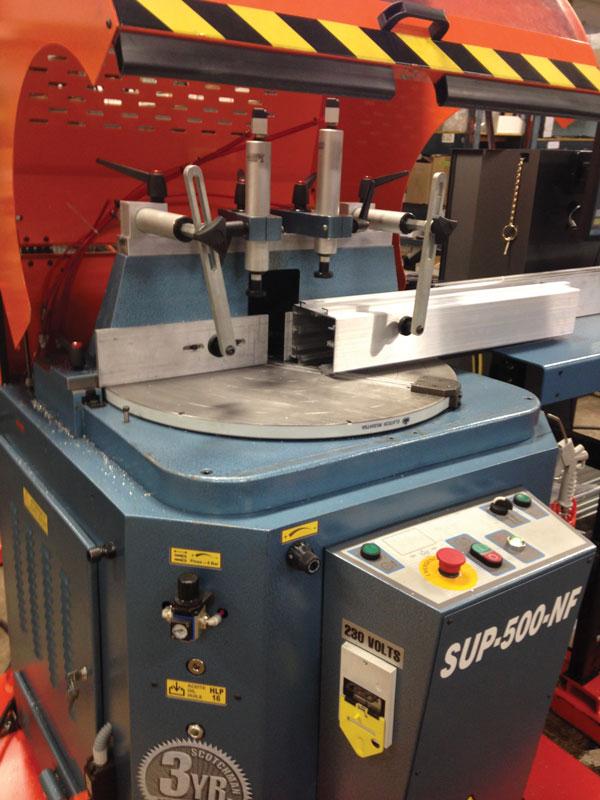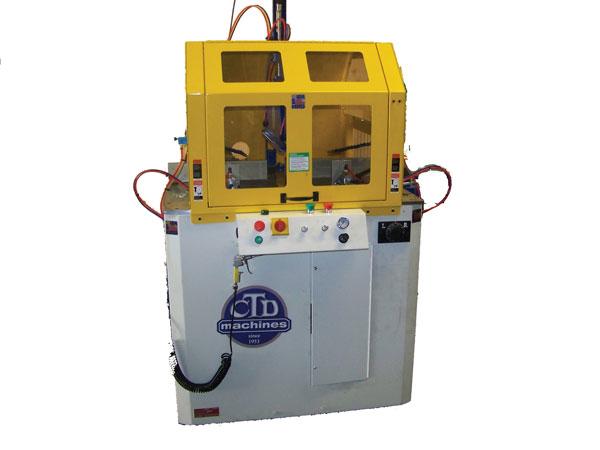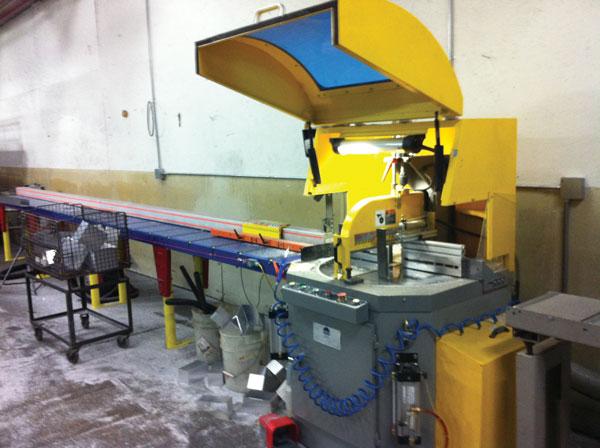- FMA
- The Fabricator
- FABTECH
- Canadian Metalworking
Cutting up Is No Laughing Matter
Upcut saws are turning out more parts in more shops
- By Sue Roberts
- November 18, 2014
- Article
- Fabricating

Scotchman’s SUP-500 NF cuts up to a 7-in.-diameter round and up to a 11.75- by 5-in. rectangle with a 20-in. blade rotating at 3,000 RPM. Photo courtesy of Scotchman Industries.
An upward-trending construction market is calling for more cut-to-length aluminum profiles for the fenestration industry. Shops are creating their own aluminum blanks to feed machining processes. Aluminum components are replacing ferrous parts in a number of industries to reduce the weight of the end products—for example, in vehicles from personal autos to emergency vehicles. These market activities are creating an uptick in the amount of aluminum being processed on the shop floor.
Upcut saws are stepping up to keep manufacturers on task and competitive with increased productivity, accuracy, and cut quality; complex mitering abilities; and built-in safety systems.
Machines designed for straight 90-degree cuts or equipped with automatic saw head rotation tables are cropping up in shops dedicated to producing thousands of like pieces and in facilities that produce custom parts on a just-in-time basis.
“Upcuts have been used for years in the window and door industry, but now they are branching out into industries that want to lighten up products,” said Mike Albrecht, national sales manager at Scotchman Industries, Philip, S.D. “The growing sector of aluminum and nonferrous cutting is creating the larger market.”
Bigger Blades Equal More Capacity
The productivity of an upcut saw begins with an oversized blade, up to 36 inch diameter on some machines. The larger blade size and typically higher horsepower can cut through thicker rounds, squares, and profiles or more bundled or stacked materials in one stroke than many of the pull-down saw counterparts.
Larry Lehmann, outside sales manager at CTD Machines, Los Angeles, Calif., said, “With a 22-in. blade on an upcut you can cut material that is 1 in. high by 20 in. wide, so your capacity is there. The limiting factor is going to be how fast you can get through the material without having blowout on the bottom or top, but you can get faster cycle times with a shorter stroke. Set the stroke of the saw so it starts just barely below the table and just barely goes through the material before retracting down. The cut itself might take the same amount of time, but a chop saw has a longer stroke to get back to the safe mode.”
Putting control of the feed rate with the machine can also save time by removing pull-down speed variations caused by the operator and opportunities for damage that can occur with manual operations.
Automation Speeds Production

The Whirlwind upcut saw from CTD Machines, available with a miter option, has a 20-in. blade capable of cutting material up to 20 in. wide by 1 in. high; 17 in. wide by 4 in. high; 12 in. wide by 6 in. high; or 4.5 in. wide by 8 in. high. Photo courtesy of CTD Machines.
Pairing upcut saws with automation to handle all movements, including loading, measuring, blade speed, and blade disk rotation for mitering, provides the biggest boost to upcut process productivity.
“Some of our models have automated drive systems that turn the saw disk, so the miter can be easily programmed. You can program the control to cut 45 degrees in one direction, and to match the profile for the opposite cut. Pair it with a feeding system and all the operator has to do is load the machine and punch the buttons to get the needed lengths and cuts,” Albrecht said. “When a full automation package isn’t purchased, I normally team an upcut with some kind of measuring system because with the price of extrusions, you don’t want to waste material. Inaccurate cut parts are wasted money.”
The heat generated by cutting the nonferrous materials that are appropriate for an upcut process doesn’t warrant a flood of lubricant. An economical drip or misting system is enough.
Lehmann explained that a light lubricating system directed at the blade controls the temperature for a quality cut and keeps chips out of the gullets of the blade to extend blade life. “With the nonferrous saws we use either a biodegradable lubricant with a lube misting system or a saw lubrication system with a lubricant mixed with oil. Both can be metered to directly hit the blade. The lubricant evaporates as it cools, leaving very little, if any, residue on the finished part. So there is usually no cleanup.”
The tabletop design of an upcut saw cabinet prevents most chips from falling through the blade opening and encloses them in an area where they can be removed by vacuum collectors attached to ports on the back of the machine. This also helps reduce the danger of explosion that goes handin- hand with cutting or grinding aluminum.
Cut finish, although always influenced by blade quality, also benefits from the upcut process.
“The high blade speed from an upcut provides a nice finish and you get the benefit of having the material clamped so it does not move during the cutting. That helps the finish and improves the accuracy. In our saws we clamp from the top and the side,” said Thornton.
Safety Is Huge
An upcut saw’s large, rotating blade creates a lot of inertia. So multiple safety features prevent the spinning blade from cutting anything other than properly positioned material. A top cap protects against the rotating blade when it comes up through the table to make a cut. Protective hoods enclose the working components of the saws to provide another layer of protection from the blade and confine flying chips. The hoods also eliminate the option of having an operator manually hold the material while it is being cut.
Dual palm buttons must be simultaneously depressed to activate the clamping and cutting cycles and also work to keep the operator’s hands well away from the cutting action.

A rotating 20-in. blade on Pat Mooney’s PMI-20 upcut saw creates left and right miters without repositioning the material. The ground surface and chromate coating on the 355⁄8- by 355⁄8-in. worktable prevent marring on the outside of the workpiece. Photo courtesy of Pat Mooney Inc.
When resting, the blades retract into the cabinet, making the teeth inaccessible. Sensors and limit switches prevent the blade from activating when the hood is up, clamps are not securing the material, or the cabinet door is opened to change the blade or for equipment maintenance.
Layers of safety redundancy are built in.
“We are seeing a lot of companies with existing chop saws adding an upcut,” said Lehmann. “They are cutting profiles for windows or storefronts, aluminum piping, even copper tubing. They’re not getting rid of the chop saws, but they want the increased capacity and safety of an upcut.”
subscribe now


Keep up to date with the latest news, events, and technology for all things metal from our pair of monthly magazines written specifically for Canadian manufacturers!
Start Your Free Subscription- Trending Articles
- Industry Events
MME Winnipeg
- April 30, 2024
- Winnipeg, ON Canada
CTMA Economic Uncertainty: Helping You Navigate Windsor Seminar
- April 30, 2024
- Windsor, ON Canada
CTMA Economic Uncertainty: Helping You Navigate Kitchener Seminar
- May 2, 2024
- Kitchener, ON Canada
Automate 2024
- May 6 - 9, 2024
- Chicago, IL
ANCA Open House
- May 7 - 8, 2024
- Wixom, MI














